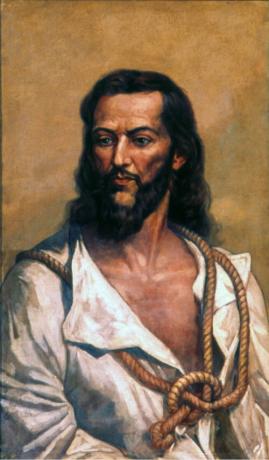On April 21, Tiradentes Day is celebrated., nickname was given to Joaquim José da Silva Xavier (1746-1792), who was known to have been the only participant in the Mining Inconfidence, held in 1788, to receive the death penalty. He was accused of conspiracy by the Portuguese Crown authorities and was killed on the day April 21, 1792.
In addition to his interest in political activity, Joaquim José da Silva Xavier exercised several professional activities, including that of amateur dentist, which ended up earning him the nickname Tiradentes.
Read too: November 20 – Black Consciousness Day
Tiradentes and the Minas Inconfidência

Tiradentes held the rank of military in the Dragons' cavalry, a position that guaranteed him some money and gave him some social influence. It was through the relationships he had with intellectuals, miners, clerics and other prominent people in villagerich (current Goldblack), also interested in a rebellion against the local government of the Captaincy of Minas Gerais, at the time represented by the
Viscount of Barbacena, what Tiradentes decided to join the conspiracy.It is known that the ideas of the inconfidentes, including those of Tiradentes, were largely influenced by the EnlightenmentFrench, but there was also a bit of the "liberators of America", that is, the men who made the United States Independence. THE Tiradentes's desire for the independence of Minas Gerais came about because of these ideas.
However, the conspiracy project did not even leave the plane of ideas. One of the conspirators, calledSilverio dos Reis, denounced the plan to the governor Viscount of Ouro Preto, thinking that, with such a gesture, he would be able to pay off the debts he had with the Crown. Thus, the main leaders of the Inconfidência were captured, tried and punished. Some received the penalty of exile (forced exile) to African continent. Tiradentes was the only one caught outside of Minais Gerais. He was arrested in Rio de Janeiro, where he was also convicted and killed, on the gallows, in April 21, 1792. In addition, Tiradentes' body was the subject of a procedure considered “exemplary” by the Portuguese authorities. Let's see how Lucas Figueiredo narrates:
“Tiradentes, the weakest point in the warp, had the cruelest end. After three years of imprisonment, he was hanged and dismembered. So that the subjects of the Crown would never forget the lesson, Tiradentes' head was driven into a stake. and exhibited in a public square in Vila Rica, and its members, scattered along the road that led to Rio de January."|1|
See too: September 7 - Independence of Brazil
Tiradentes as a symbol of national heroism
With the Independence of Brazil, in 1822, a process of construction of the idea of “nation” and “Brazilian people” began. This process had its kick-off in the field of arts (mainly the literature of the Romanticism) and in the field of scientific research (botany, geography, history, etc.). With the advent of Republic, in 1889, this process took on a new face. It was time to list the symbols and heroes of the nation. Tiradentes, who was considered a traitor by the Portuguese Crown, was taken up as a symbol of resistance and freedom.
Many paintings were painted at the beginning of the Brazilian republican period to portray Tiradentes as a martyr. But it was only in 1965, when the marshal CastleWhite, then President of the Republic, sanctioned the Law No. 4. 897, of December 9, that April 21st became a national holiday and Tiradentes officially became Patron of the Brazilian Nation.
Note
|1| FIGUEIREDO, Lucas. Good luck!, The Gold Rush in Brazil [1697-1810]. Rio de Janeiro: Record, 2011. P. 297.



